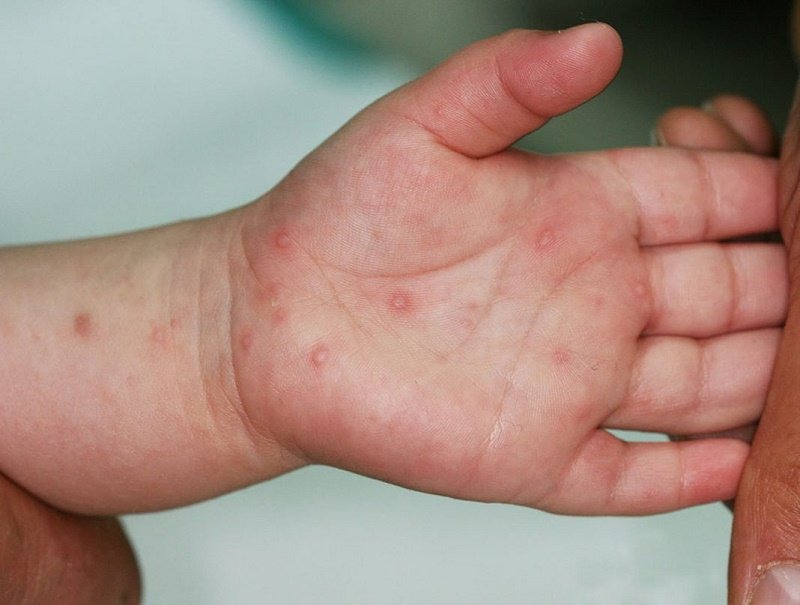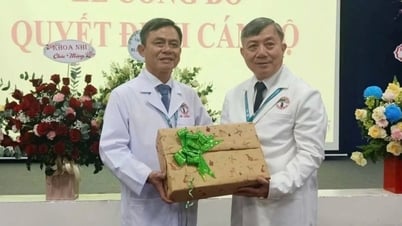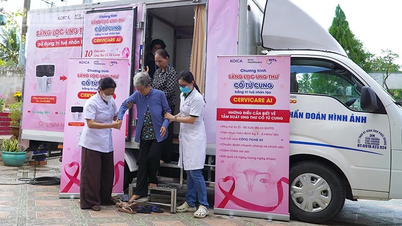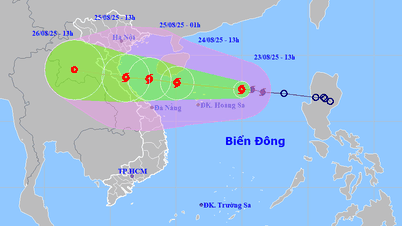If not detected and treated promptly, hand, foot and mouth disease can lead to dangerous complications such as encephalitis - meningitis, myocarditis, acute pulmonary edema, and even death.
Medical news December 8: Be careful with hand, foot and mouth disease in children
If not detected and treated promptly, hand, foot and mouth disease can lead to dangerous complications such as encephalitis - meningitis, myocarditis, acute pulmonary edema, and even death.
Be careful with hand, foot and mouth disease in children
Recently, a 20-month-old boy (LMN) was brought to the clinic with symptoms of high fever, blistering rash, and signs of severe infection.
 |
| Illustration |
After examination and testing, the baby was diagnosed with grade 1 hand, foot and mouth disease with secondary infection caused by EV71 virus.
Detecting dangerous viral infections that can cause death from common symptoms
Baby N. was brought to the clinic with a rash of blisters in many areas of the body such as the oral mucosa, tongue, hands, feet, thighs, buttocks, and knees.
The child had a high fever (39°C), poor appetite, and loose stools (3 times/day). After examination, the doctor found that the child's oral mucosa had oval-shaped ulcers distributed on the back of the throat. Blisters appeared on the palms, soles, buttocks, and knees, accompanied by purulent secondary infections.
The initial preliminary diagnosis was grade 1 hand, foot and mouth disease with secondary infection. However, PCR test results later confirmed that the baby was infected with the EV71 virus, an agent that can cause serious complications if not treated promptly.
Hand, foot and mouth disease is an infectious disease caused by intestinal viruses, commonly found in children under 5 years old. The disease is spread mainly through the digestive tract and can cause epidemics. Common viruses that cause the disease are Coxsackie virus A6, A10, A16 and Enterovirus 71 (EV71).
Hand, foot and mouth disease causes damage to the skin and mucous membranes, with blisters often appearing in areas such as the mouth, palms, feet, buttocks and knees.
If not detected and treated promptly, the disease can lead to dangerous complications such as encephalitis - meningitis, myocarditis, acute pulmonary edema, and even death. Serious complications are mainly caused by the EV71 virus.
Currently, there is no specific treatment for hand, foot and mouth disease. Therefore, treatment is mainly supportive to help children recover quickly.
Dangerous complications such as pneumonia, respiratory failure, and myocarditis can lead to death if not detected and treated promptly.
Parents need to pay attention to monitoring indicators such as SpO2 (blood oxygen concentration) and pulse status to detect early signs of abnormalities.
Children need to be re-examined 1-2 times within 8 days of treatment to monitor their condition. If the child shows unusual signs such as being startled, having difficulty breathing, having a high fever that does not go down, or vomiting a lot, the child should be re-examined immediately.
Hand, foot and mouth disease is a contagious disease and can cause dangerous complications if not treated promptly.
Early detection of signs and taking children to the doctor as soon as symptoms appear is very important to avoid the risk of death. Parents need to pay special attention and monitor their children's health throughout the treatment process.
Rapid weight loss and detection of dangerous autoimmune disease
A 24-year-old female student in Ho Chi Minh City had to face a dangerous autoimmune disease when she was diagnosed with Basedow's disease - an autoimmune thyroid disease that currently cannot be completely cured.
She lost nearly 10kg in 6 months, along with symptoms of fatigue, hand tremors, anxiety, and a lump in her neck.
The TQTD patient came to the hospital in a state of anxiety when she saw unusual changes in her body. Over the course of 6 months, she lost 9kg, felt nervous, had palpitations, had hand tremors, and had a lump in her neck.
Although the initial clinical examination showed no abnormalities, the doctors discovered diffuse hyperplasia of the thyroid gland and signs of inflammation through thyroid ultrasound. Thyroid function tests also showed elevated levels, a clear sign of autoimmune thyroid disease.
With typical symptoms of thyrotoxicosis syndrome (weight loss, anxiety, hand tremors, rapid heart rate) and signs of changes in thyroid morphology on ultrasound, the doctor concluded that the patient had Basedow's disease.
Doctor Nguyen Thi Phuong, Laboratory specialist, Medlatec healthcare system said, Basedow is a typical autoimmune disease of the thyroid gland. This is a disease that cannot be completely cured but requires long-term monitoring and treatment, helping patients control the disease and prevent complications."
Basedow's disease is an autoimmune disease of the thyroid gland that occurs when the body produces antibodies against the TSH receptor, stimulating the thyroid gland to produce thyroid hormone uncontrollably.
Common symptoms of the disease include: nervousness, palpitations, feeling of suffocation, digestive disorders, rapid weight loss, bulging eyes and a lump in the neck area.
If not detected and treated promptly, the disease can lead to dangerous complications such as stroke, heart failure and heart problems, thinning bones, osteoporosis, thyroid storm (sudden increase in life-threatening symptoms).
This disease is more common in women than men, the incidence in women is 5-10 times higher than in men. Basedow can occur at any age, but is most common in people aged 20-40.
Although Graves' disease cannot be cured, current treatments can help control the disease and relieve symptoms. Treatments include antithyroid medications, surgery, and radioactive iodine.
These methods can help restore thyroid function, and in some cases, antithyroid drugs can even make thyroid-stimulating antibodies disappear, helping to improve symptoms of the disease.
However, when the drug is stopped, these antibodies can return, especially when there are favorable factors such as bacterial infection, viral infection, or pregnancy.
Although there is no cure, with proper treatment and regular monitoring, patients can still live a healthy life and minimize complications of the disease. All patients with Graves' disease need to be monitored throughout their lives to ensure stable thyroid function.
With Graves' disease, early detection and timely treatment are very important to prevent dangerous complications. Patients need to comply with the treatment regimen and have regular check-ups to ensure stable health.
For patients with Basedow's disease, monitoring thyroid indices and maintaining long-term treatment are extremely necessary.
When there are unusual signs such as weight loss, anxiety, or a lump in the neck, the patient should see a doctor immediately for timely diagnosis and treatment.
Signs of unusual pain need to be alert for cyst rupture
A 21-year-old female patient presented to the hospital with a dull abdominal pain that lasted 18 hours. After examination, the patient was diagnosed with ruptured Degraff cyst.
18 hours before being admitted to the hospital, patient PTK (21 years old, Hanoi ) had a dull pain in the lower abdomen, not in attacks and not improved when changing position. Worried, Ms. K. was taken by her family to Medlatec General Hospital for examination.
Clinical examination revealed pain in the lower abdomen. Blood tests showed sepsis with elevated WBC count, neutrophil count up to 79%.
Abdominal ultrasound showed a mixed mass next to the right ovary, with free fluid in the abdomen. Beta hCG test results ruled out the possibility of ectopic pregnancy. From there, the doctor determined that the patient had a ruptured Degraff cyst.
The patient was transferred to the Central Obstetrics Hospital for further monitoring. Ultrasound results showed no change in abdominal fluid, symptoms gradually decreased, and hemodynamics were stable. Fortunately, Ms. K. did not require surgery and was discharged after treatment.
Degraff cysts are physiological follicles that appear in healthy women. When the follicle develops to its maximum size, it is called a Degraff cyst. Normally, Degraff cysts are 18-28mm in size.
When it reaches its maximum size, it will release an egg and then become a corpus luteum. However, in some cases, a Degraff cyst does not release an egg but ruptures, causing blood to leak into the abdomen.
Ovarian cysts may be asymptomatic, or have unclear symptoms if they are small. However, when the cyst grows larger, the patient may experience symptoms such as pain in the lower abdomen, pain during intercourse, menstrual disorders, or a palpable mass in the pelvis. In particular, you should see a doctor immediately if you have sudden, severe lower abdominal pain, accompanied by nausea, vomiting, or fever.
There are two types of ovarian cysts: functional cysts (benign) accounting for 90% and organic cysts. Most functional cysts will shrink on their own without causing complications.
However, when the cyst ruptures, blood and fluid in the cyst will spill into the abdominal cavity, causing infection and possibly leading to pelvic peritonitis, which is life-threatening if not treated promptly.
If not detected and treated promptly, a ruptured ovarian cyst can cause severe bleeding, shock, or lead to infertility.
To diagnose a ruptured cyst, the doctor will perform a clinical examination, take a medical history, and prescribe some diagnostic methods such as ultrasound and blood tests to rule out other causes such as ectopic pregnancy.
Doctors recommend that women should have regular health check-ups and gynecological examinations. If you experience unusual symptoms such as abdominal pain, menstrual disorders or prolonged pelvic pain, you should see a doctor for early treatment to avoid serious complications.
Source: https://baodautu.vn/tin-moi-y-te-ngay-812-can-trong-voi-benh-tay-chan-mieng-o-tre-em-d231937.html






![[Photo] General Secretary To Lam attends the 80th Anniversary of the Cultural Sector's Traditional Day](https://vphoto.vietnam.vn/thumb/1200x675/vietnam/resource/IMAGE/2025/8/23/7a88e6b58502490aa153adf8f0eec2b2)





















![[Photo] Prime Minister Pham Minh Chinh chairs the meeting of the Government Party Committee Standing Committee](https://vphoto.vietnam.vn/thumb/1200x675/vietnam/resource/IMAGE/2025/8/23/8e94aa3d26424d1ab1528c3e4bbacc45)
































































Comment (0)